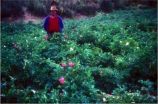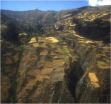(Press-News.org) Mashed, smashed and fried, Americans love potatoes, but only a few varieties are grown in much of North American agriculture. In South America, where potatoes originated, more than 5,000 varieties continue to exist. A Penn State geographer is gathering all the information he can about the agrobiodiversity of these uniquely adapted tubers with an eye toward sustainability of this fourth largest food crop worldwide.
"In the U.S. we rely primarily on 10 to 12 types of potatoes total," said Karl Zimmerer, department head and professor of geography. "In fact, mostly we use only 5 to 8 varieties. In South America, by contrast, there are 74 different types of potatoes in a single field. The fields, tubers and landscapes are visually stunning."
Zimmerer has studied high-agrobiodiversity land use for over 20 years, but until recently, those studies have been on the ground. He first looked at diversity within individual potato fields and then scaled up to individual communities and landscapes. People in a community have expert knowledge of 150 to 180 varieties of potato, he said.
"People in Peru, for example, love to eat potatoes and think that theirs are vastly superior to what we have in flavor, texture, starchiness and color," said Zimmerer. "They want to hang on to their high-agrobiodiversity potatoes and we want them to hang due to nutritional, ecological and other conservation advantages."
Scaling up even more, Zimmerer looked at potato fields on the landscape level -- typically groups of 5 to 15 communities -- and regions that contain upward of 30 or 40 communities. Remote sensing approaches made this easier, but still only supplied part of the answers to identifying agrobiodiversity hotspots -- biologically rich but environmentally and socioeconomically threatened areas -- and creating ways to protect these areas and conserve these crops. Because the major potato growing area encompasses large parts of northern South America, Zimmerer needed a novel approach, which he presented today (Feb. 15) at the annual meeting of the American Association for the Advancement of Science in Chicago, where he organized a symposium on new agrobiodiversity discoveries needed for sustainability.
"There are 4,000 to 5,000 different varieties of potato in Chile, Colombia, Northern Argentina, Peru, Bolivia, Ecuador and Venezuela," said Zimmerer. "Up until now, the areas where varieties grow were just designated as large, undifferentiated shapes on the map. In order to support agrobiodiversity, we have to have an idea of large-area agrobiodiversity concentrations, so we have to look from the top down."
With this approach, identifying and analyzing region-scale areas of concentrated agrobiodiversity are important, as are the global institutions such as the International Potato Center in Peru. But perhaps the most important part of the top down study is the knowledge held by expert potato taxonomists who have long histories of geographically extensive work.
"One example is Alberto Salas who has 60 years of experience and has vast geographic and agrobiodiversity knowledge," said Zimmerer. "He is a Peruvian who has worked from Chile to Venezuela and has an extraordinary knowledge of major areas where diverse potato types are located."
While many experts are local to potato growing areas, other experts come from Europe and North America. To assemble an expert database of information about locations of potato hotspots, Zimmerer uses a two-pronged approach. For those comfortable with computers, he asks them to delineate on Google Earth maps the regions of concentrated agrobiodiversity. For those uncomfortable with computers, the same tasks can be performed using paper maps.
Once the regional hotspot locations are on the electronic map, other information such as elevation, socioeconomic characteristics and slope becomes available. Information from the various experts can also be compared.
With so many varieties, it is difficult for even the local farmers to identify and keep track of the potatoes growing in their and their neighbor's fields. Zimmerer's approach may eventually be used for visualizations that help enable the local crowdsourcing of this agrobiodiversity.
"The local farmers generally identify their potatoes on their culinary properties and uses -- floury, soup making or freeze drying," said Zimmerer. "Interestingly, the culinary uses correspond to the elevations where the potatoes grow -- soup potatoes have the lowest elevation, floury potatoes in mid elevation and freezing potatoes are the highest."
This type of information from the knowledge systems of farmers -- often women -- coupled with top down image analysis, visualization and geographic information systems can supply important information for sustainability and conservation. Combining the top-down and bottom-up information provides novel knowledge and new strategies for sustainable use of the extraordinarily high levels of biodiversity within the Andean potatoes.
Zimmerer is already applying this approach to other crops such as corn, which also includes many unique types with geographic dynamics being a key to adaptation and sustainability.
INFORMATION:
The National Science Foundation supported this work.
Top-down and bottom-up approach needed to conserve potato agrobiodiversity
2014-02-16
ELSE PRESS RELEASES FROM THIS DATE:
Robotic fish aids understanding of how animals move
2014-02-16
The weakly electric black ghost knifefish of the Amazon basin has inspired Northwestern University's Malcolm MacIver and an interdisciplinary team of researchers to develop agile fish robots that could lead to a vast improvement in underwater vehicles used to study fragile coral reefs, repair damaged deep-sea oil rigs or investigate sunken ships.
MacIver will discuss the research at a press briefing, "Robots from Nature: Making Mechanical Animals," to be held at 1 p.m. CST Saturday, Feb. 15, in Vevey Room 3 of the Swissôtel Chicago. The briefing is part of the American ...
Stanford scientist to unveil 50-state plan to transform US to renewable energy
2014-02-16
Stanford Professor Mark Jacobson and his colleagues recently developed detailed plans to
transform the energy infrastructure of New York, California and Washington states from fossil fuels
to 100 percent renewable resources by 2050. On Feb. 15, Jacobson will present a new roadmap to
renewable energy for all 50 states at the annual meeting of the American Association for the
Advancement of Science (AAAS) in Chicago.
The online interactive roadmap is tailored to maximize the resource potential of each state.
Hovering a cursor over California, for example, reveals ...
Research on urban ghettos must recognize differences among cities
2014-02-16
Research on urban neighborhoods must take into account differences among cities and rely on some techniques that have not been used extensively by sociologists studying neighborhood effects, according to Mario Small, professor of sociology at the University of Chicago.
Small, who is also dean of UChicago's Division of the Social Sciences, studies urban neighborhoods and has studied the diversity of experiences for people living in poor neighborhoods in cities across the country.
Studying only a few neighborhoods extensively fails to capture important differences, ...
Making biodiverse agriculture part of a food-secure future
2014-02-16
Is biodiverse agriculture an anachronism? Or is it a vital part of a food-secure future?
Given the need to feed an estimated 2.4 billion more people by the year 2050, the drive toward large-scale, single-crop farming around the world may seem inexorable.
But there's an important downside to this trend, argues Timothy Johns, Professor of Human Nutrition at McGill University in Montreal, in a paper to be presented Saturday, Feb. 15, at the annual meeting of the American Association for the Advancement of Science in Chicago.
Diets for most people around the world are becoming ...
LGB individuals living in anti-gay communities die early
2014-02-15
February 12, 2014 -- In the first study to look at the consequences of anti-gay prejudice for mortality, researchers at Columbia University's Mailman School of Public Health found that lesbian, gay, and bisexual (LGB) individuals who lived in communities with high levels of anti-gay prejudice have a shorter life expectancy of 12 years on average compared with their peers in the least prejudiced communities. "The results of this study suggest a broadening of the consequences of prejudice to include premature death," noted the study's lead author, Mark Hatzenbuehler, PhD, ...
Beat-keeping sea lion shows surprising rhythmic ability
2014-02-15
Ronan, a California sea lion at Long Marine Laboratory at the University of California, Santa Cruz, became an Internet sensation last year when UCSC scientists published a paper describing her ability to bob her head in time with rhythmic sounds and music in a variety of tempos (see video).
Ronan is the first non-human mammal convincingly shown to be able to keep the beat. Her range and versatility in matching different beats is impressive, according to Peter Cook, who began working with Ronan as a graduate student at UC Santa Cruz. Cook, now a postdoctoral fellow at ...
The new Africa -- green shoots in biosciences
2014-02-15
Cambridge UK, Feb 10, 2014: This key session will bring African experts in person to Chicago to report on how agricultural biotechnology is starting to have a real impact on the crucial smallholder farming sector in particular. However, the session will also warn that this fledgling bioscience revolution needs to be carefully nurtured. According to moderator Sir Brian Heap, African economies are now among the fastest growing in the world. "While many of the world's farmers have benefitted from advances in bioscience, African farmers and citizens could possibly benefit the ...
University institutes are shaping future of research
2014-02-15
In an age of specialization, building networks of outstanding scientists, engineers and clinicians is helping the development of creative solutions to complex societal needs. But how do you successfully surmount the barriers between disparate disciplines?
Northwestern University professor Chad Mirkin is no stranger to the challenges of building diverse teams. He is the founding director of the International Institute for Nanotechnology (IIN), a flourishing institute that brings together more than 190 faculty researchers from 25 different disciplines.
Mirkin will discuss ...
First 2014 Golden Goose Award to physicist Larry Smarr
2014-02-15
Larry Smarr, a physicist whose work at the University of Illinois at Urbana-Champaign on calculating black hole collisions led him to champion a federal commitment to dramatically enhance U.S. computing power – which in turn led to the development of NCSA Mosaic, the precursor to web browsers – was named today as the first 2014 recipient of the Golden Goose Award.
The Golden Goose Award honors researchers whose federally funded research may not have seemed to have significant practical applications at the time it was conducted but has resulted in major economic or other ...
Repeal of Missouri's background check law associated with increase in state's murders
2014-02-15
Missouri's 2007 repeal of its permit-to-purchase (PTP) handgun law, which required all handgun purchasers to obtain a license verifying that they have passed a background check, contributed to a sixteen percent increase in Missouri's murder rate, according to a new study from researchers with the Johns Hopkins Center for Gun Policy and Research.
The study, to be published in a forthcoming issue of Journal of Urban Health, finds that the law's repeal was associated with an additional 55 to 63 murders per year in Missouri between 2008 and 2012.
State-level murder data for ...




